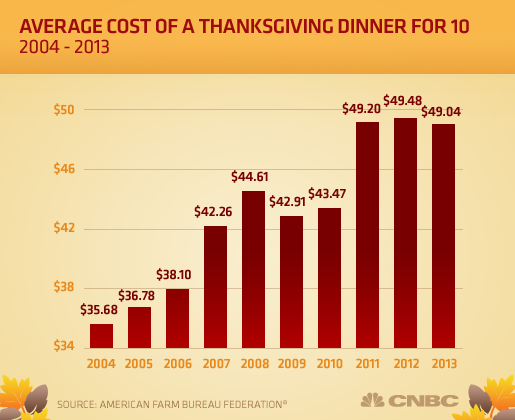Come this time of year, the business press gets a press release from the American Farm Bureau Federation reporting how much the average Thanksgiving dinner will run you this year.
Every year, hundreds of outlets dutifully run stories about the press release, adding as much hype and tension as possible, and grandparents across the land fold their papers and carp about how inflation is out of control these days, even though it’s not, and grandkids roll their eyes.
Some who know better cynically use the inherent volatility of food prices to bolster their ideological position.
A couple of years ago, I noticed the hard money types at The Wall Street Journal editorial page hyping the “runaway inflation” signaled by this single datapoint, which was refuted by the rest of the data (not to mention that there were turkey supply constraints—unmentioned by the WSJ, of course— that drove up the cost that year):
We keep hearing that inflation has not gotten out of control despite all the Federal Reserve’s money creation over the last few years, but there’s at least one place where you’re seeing pretty substantial inflation.
I thought that was about as concise an example of misleading with anecdotes as you could find, and then I read this 2011 headline from MoneyNews, also a right-wing outlet:
Higher Thanksgiving Prices Show True Inflation Rate
But it’s not just ideologues who mislead with the turkey goblin. The mainstream press does too, and it’s revealing to look at how and why.
First, there’s angle inflation and the editorial drive for tension. Your chances of getting your byline noticed are higher with a story that reads “Turkey prices gobble up more of Thanksgiving bill” than with “Thanksgiving bill flat.” Flat means no tension, and editors love tension.
So last year, when Thanksgiving dinner prices were up just 28 cents to $49.48 for a feast for 10, reporters still found a way to ratchet up the tension. See this CNBC story, which also ran in USA Today, with the above headline, “Turkey prices gobble up more of Thanksgiving bill.” That was technically accurate but misleading, implying as it did that Thanksgiving prices were rising overall when they were actually falling, as we’ll see in a bit.
The cost of a classic Thanksgiving dinner edged up slightly, but it could have been lower this year had it not been for the meal’s traditional centerpiece, the turkey.
Another big reason for these poor reports is plain old journalistic innumeracy. Journalists, like readers, tend to be biased toward seeing price increases, and journalists, like readers, tend to be bad at math. So you get CNBC somehow calculating that the overall 2012 dinner price rose 3 percent when the nominal increase was actually 0.6 percent and the real increase was negative 1.4 percent.
This year, the AFBF is reporting that the price of Thanksgiving dinner will fall from $49.48 last year to $49.04 this year, a 0.9 percent decline and a 2.8 percent fall in real dollars.
So how does the press handle it when Thanksgiving dinner prices actually fall? Will there be a raft of stories about how this tiny slice of consumer expenditures means we’re in a deflationary spiral? Yeah, right.
Here’s the Los Angeles Times:
Thanksgiving dinner cost falls from last year’s record to $49.04
Note the framing here. The cost “falls”—but from last year’s “record” price, which implies that it’s still sky-high.
But last year’s price wasn’t a record at all. It wasn’t even close. When you adjust for inflation, last year’s Thanksgiving dinner cost $12 less than it did in 1986, when grandpa still had sideburns. Here’s what the LAT says:
When the Farm Bureau survey was first launched in 1986, the nominal cost of the full Thanksgiving dinner was $28.74. The cost has hovered around $49 since 2011.
Why would you report the nominal price of something in 1986 and not also report the inflation-adjusted price? Lots of readers don’t even know what “nominal cost” means.
CNBC, meanwhile, does okay until it gives us this misleading chart that shows prices that aren’t adjusted for inflation:
And it says, “Interestingly, the roughly 1-percent drop in the Thanksgiving dinner costs come as food prices in general have risen.”
Actually it’s not interesting, which points to another aspect of the innumeracy problem: statistics. Thanksgiving prices count a dozen foods out of the hundreds the Bureau of Labor Statistics surveys to come up with overall food costs. They’re such a statistically insignificant sample that they’re not very meaningful.
Here’s how the Associated Press handles the news:
Here’s another reason to be thankful this holiday season — the cost of putting Thanksgiving dinner on the table is down slightly from last year.
But don’t bank on those savings for any big Black Friday splurges. The average Turkey Day dinner will cost $49.04, or just 44 cents less this year than it did in 2012. And while every penny counts, if you need to do any traveling to belly up to the big meal, increases in airline and train tickets mean that 44 cents won’t get you very far.
It still has to rain all over our Macy’s Thanksgiving Day Parade. But okay, at least it’s not misleading.
Ryan Chittum is a former Wall Street Journal reporter, and deputy editor of The Audit, CJR’s business section. If you see notable business journalism, give him a heads-up at rc2538@columbia.edu. Follow him on Twitter at @ryanchittum.

